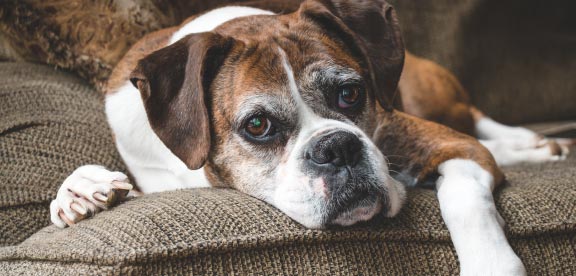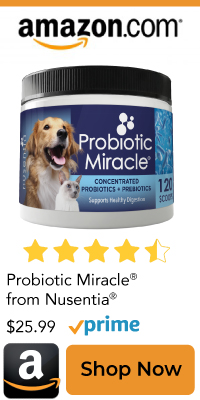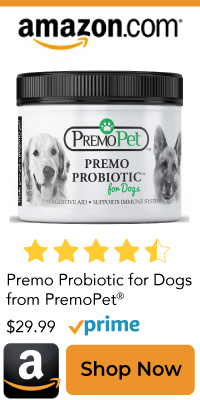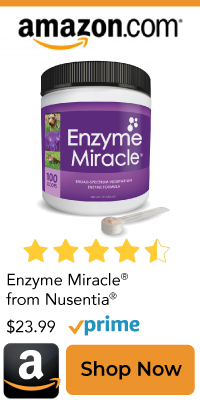Why does my dog have yeast?
Yeast overgrowth in dogs can manifest in a rash (yeast rash, dermatitis), ear infection, or bad smell on the body. For whatever reason, your dog's body has become imbalance. Yeast can overgrow or turn into an infection almost anywhere on the body of your dog's health is not kept in check.
Probiotics are the answer to stopping recurring yeast infections. *
Signs of Dog Yeast Infection
- Excessive rubbing of the ears
- Waxy residue and scabbing around the opening of the ear
- Scabby, or reddened skin
- Yellow, or bloody discharge
- Unusual Odor
- Hair loss around the ear
- Appearance of Disorientation; loss of balance, hearing, walking in circles
What Causes Yeast Overgrowth
There is usually an underlying issue causing a yeast infection. Yeast can be caused by allergens, antibiotics, environment, and some breeds are more susceptible to yeast infections, especially in the ears.
How to Prevent Yeast Infections
Yeast infections in dogs are typically treated with drugs, but can many times be avoided and improved through natural health maintenance and nutrition:
- Probiotics
- Feed as close to raw and grain-free as possble
Top Healthy Raw Dehydrated Dog Foods
If an ear infection from yeast has already taken hold on your dog, it is important to seek the advice of your vet as ear infections generally need to be treated locally first. But if you find that your dog is prone to ear infections, many dog owners have been able to reduce their occurance, some completely, with nutrition and local maintenance.*
At Home Ear Wash
Step 1: To avoid yeast infections in the ears, give your dog a natural ear wash once a week using 50% rubbing alcohol and 50% white vinegar. Squeeze the solution into your dogs ear and massage at the base of the ear. Allow your dog to shake the liquid out, then use cotton to clear out the debris of wax and dirt. This process will keep the ear clean and dry, while the vinegar stops the bacteria from growing. Continue once per week.*
If your dog has longer hair, you will need to pull the longer inside hairs out of the ear on occasion.
Treating Yeast Infections on the Skin
Keep the area dry and clean. Shave the area if possible. When you clean the area of yeast on your dog, use cool water (if any at all). You can also fill a spray bottle with 50% water and 50% apple cider vinegar and spray the solution directly on the skin. This is very effective in drying the area out and keeping the yeast from growing locally. Do not use cleansers or harsh shampoos as they can further aggravate yeast. If possible, try to prevent your dog from liking the area—a collar may be in order.
Treating and Preventing Yeast Through Nutrition
Give your dog probiotics and enzymes daily to keep yeast growth in check. Make sure to remove grains from his diet and feed raw when possible. Especially after medication, or during an allergy season, a yeast infection could be waiting in the shadows, ready to take over. In addition to a grain free raw diet, probiotics and enzymes are an excellent way to avoid yeast overgrowth at the foundation.
How Enzymes and Probiotics Combat Yeast:
Probiotics eat yeast and crowd out the pathogenic (harmful) bacteria that yeast needs to survive in your dog. Key enzymes (such as beta-glucanase) can help your dog to further break down yeast and fungi directly. Other enzymes help streamline the digestive process to reduce waste and bacteria-causing fermentation that your dog's body may rely on for digestion when natural enzymes are not present in his food. From the inside out, probiotics and enzymes are the most efficient way to assure that yeast growth stays in check with your dog. A good combination of probiotics and enzymes can be found from Nusentia (The Miracle Pack, or MiracleZyme tablets)
How Fast Can I Expect To See Results?
While every dog is different, we see consistent positive results with Probiotic Miracle® when addressing yeast infections and recovery. Initial improvement with yeast infections can happen very quickly. While some have reported positive results in as little as a week, we recommend waiting 6-8 weeks before noticing lasting results. Once your dog is clear of yeast, continue a maintenance dose of probiotics to keep yeast levels in check.
Our dog, Rascal, had a rash and a very bad smell from her rear end. I tried everything to get rid of it including spending hundreds on prescriptions from the vet that just seemed to make things worse. Wow, she really smelled terrible and seemed miserable. We heard that probiotics for dogs could help with yeast overgrowth and a friend also recommended using the digestive enzymes. We decided to try the Miracle Pack which is the enzymes and probiotics. When we started adding the probiotics and digestive enzymes to her food, her rash cleared up within 2 weeks and there really is no smell from her rear end any more. We could see most of the improvement just after the first week! Thank you! — Rachel B, California
Top Sellers in Dog Probiotics
Why Probiotics for Dogs?
Most dogs are deficient in healthy flora. Here's why:
- Dogs on antibiotics will be deficient in healthy gut bacteria since antibiotics strip the gut of ALL bacteria.
- Senior dogs will naturally have a lower volume of healthy bacteria.
- Dogs fed processed dry kibble are susceptible to low healthy microflora.
- Drinking municpal water treated with chemicals
- Stress contributes to an imbalance in the microbiome (dog's gut).
- Puppies are born with probiotic deficiency as their guts sterile. Supplementing your puppy with probiotics early on may give them a "leg up" on fighting illness later on.
Benefits
- Better skin and coat appearance
- Improved breath and body smell
- Less gas (flatulence)
- Fewer allergy symptoms
- Reduction in yeast issues
- Regular bowel functions
Signs of Deficiency
- Diarrhea
- Constipation
- Itching and allergies
- Poor immune function
- Skin irriations

7 Signs Your Dog Needs Probiotics
If your dog is showing some of these symptoms, chances are he needs probiotics and digestive support.

Are Probiotics Safe for Puppies?
Probiotics are highly recommended for puppies and young dogs, here's why...
Cites and References
- Hatoum, Rima et al. “Antimicrobial and probiotic properties of yeasts: from fundamental to novel applications.” Frontiers in microbiology vol. 3 421. 19 Dec. 2012, doi:10.3389/fmicb.2012.00421
- Mundula, Tiziana et al. “Effect of Probiotics on Oral Candidiasis: A Systematic Review and Meta-Analysis.” Nutrients vol. 11,10 2449. 14 Oct. 2019, doi:10.3390/nu11102449
 Probiotics for dogs: Probiotic Miracle
Probiotics for dogs: Probiotic Miracle Probiotics for dogs: Premo Probiotic
Probiotics for dogs: Premo Probiotic Enzymes for Dogs: Enzyme Miracle
Enzymes for Dogs: Enzyme Miracle